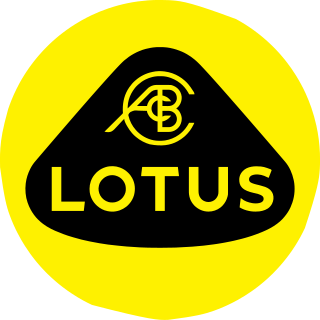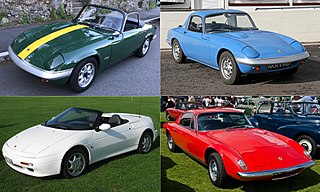
The Lotus Seven is a sports car produced by the British manufacturer Lotus Cars between 1957 and 1972. The Seven is an open-wheel car with two seats and an open top. It was designed by Lotus founder Colin Chapman and has been considered the embodiment of the Lotus philosophy of performance through low weight and simplicity. The original model was highly successful with more than 2,500 cars sold, due to its attraction as a road legal car that could be used for clubman racing.

Cosworth is a British automotive engineering company founded in London in 1958, specialising in high-performance internal combustion engines, powertrain, and electronics for automobile racing (motorsport) and mainstream automotive industries. Cosworth is based in Northampton, England, with facilities in Cottenham, England, Silverstone, England, and Indianapolis, IN, US.

Lotus Group is a British multinational automotive manufacturer of luxury sports cars and electric lifestyle vehicles.

The Lotus Elise is a sports car conceived in early 1994 and released in September 1996 by the British manufacturer Lotus Cars. A two-seater roadster with a rear mid-engine, rear-wheel-drive layout, the Elise has a fibreglass body shell atop its bonded extruded aluminium chassis that provides a rigid platform for the suspension, while keeping weight and production costs to a minimum. The Elise was named after Elisa Artioli, the granddaughter of Romano Artioli who was chairman of Lotus and Bugatti at the time of the car's launch.

Anthony Colin Bruce Chapman was an English design engineer, inventor, and builder in the automotive industry, and founder of the sports car company Lotus Cars.
Donald Mitchell Healey CBE was a noted English car designer, rally driver and speed record holder.

The Lotus Europa name is used on two distinct mid-engine GT cars built by British automobile manufacturer Lotus Cars. The original Europa and its variants comprise the Lotus Types 46, 47, 54, 65 and 74, and were produced between 1966 and 1975.
Westfield Sportscars is a manufacturer of both factory built and kit versions of several two-seater, open top sportscars. Their main product is a Lotus Seven inspired car – vehicles originally designed by Colin Chapman with only the bare essentials for motoring in order to give the rawest and most exhilarating driving experience.

The Caterham 7 is a super-lightweight sports car produced by Caterham Cars in the United Kingdom. It is based on the Lotus Seven, a lightweight sports car sold in kit and factory-built form by Lotus Cars, from 1957 to 1972.

Lotus Elan is the name of two separate ranges of automobiles produced by Lotus Cars. The first series of cars was produced between 1962 and 1975 as a rear-wheel drive vehicle. The second series was produced between 1989 and 1995 as a front-wheel drive vehicle.

The Lotus Excel is a sports car designed and built by British automobile manufacturer Lotus Cars from 1982 to 1992. It is based on the design of the earlier Lotus Eclat, which itself was based on the earlier Lotus Type 75 Elite.

The Lotus Carlton is a version of the Vauxhall Carlton/Opel Omega A saloon upgraded by Lotus in order to be a high performance sports sedan. Like all Lotus vehicles, it was given a type designation—Type 104 in this case.

The Tesla Roadster is a battery electric sports car, based on the Lotus Elise chassis, produced by Tesla Motors from 2008 to 2012. The Roadster was the first highway legal, serial production, all-electric car to use lithium-ion battery cells, and the first production all-electric car to travel more than 244 miles (393 km) per charge. It is also the first production car to be launched into deep space, carried by a Falcon Heavy rocket in a test flight on February 6, 2018.

The Lotus Elise GT1 is a race car developed for grand tourer-style sports car racing starting in 1997.

The Lotus Evora is a sports car produced by the British company Lotus. The car, which was developed under the project name Project Eagle, was launched on 22 July 2008 at the British International Motor Show. The Evora S was launched in 2010 with a supercharged 3.5-litre V6. A facelifted and more powerful Evora 400 model was unveiled at the 2015 Geneva Motor Show, followed by another more powerful variant, the Evora GT430, which was unveiled in 2017.
The Lotus Esprit GT1 was a sports racing car produced by Lotus Engineering, a subsidiary of Lotus Cars formed to develop racing cars to compete in the GT1 class racing. It competed in the BPR Global GT Series in the mid-1990s.

The Hennessey Venom GT is a limited-production high performance sports car manufactured by US manufacturer Hennessey Performance Engineering. The Venom GT is based on the Lotus Elise/Exige.

The Lotus 3-Eleven is a sports car produced by British car manufacturer Lotus Cars. The car is available as a racing version as well as a normal road legal version.
The GPV8 is a 3.5-litre and 3.8-litre, naturally-aspirated V8 engine, originally designed, developed and produced by Cosworth, for the Lotus T125 open-wheel sports car. The initial 3.5-litre V8 produced 640 hp at 9800 rpm, and 332 lb⋅ft (450 N⋅m) at 7600 rpm. The rev limit of the engine is 10,300 rpm; and can be temporarily raised to 10,800 rpm with a push-to-pass button feature. The enlarged 3.8-litre V8 is more powerful, producing 675 hp at 9600 rpm, and 361 lb⋅ft (489 N⋅m) at 7600 rpm, with a redline of 10,000 rpm. The engine's power density is between 136.3 kW and 132.4 kW per litre.
The Lotus-Radford Type 62-2 or simply Radford Type 62-2 is a sports car produced by British coachbuilding firm Harold Radford in partnership with Lotus Cars. Built as a homage to the original Lotus 62, production will be limited to 62 units. The car is available in three trim levels: "Classic", "Gold Leaf", and "John Player Special". Of the 62 planned units, twelve will be in the John Player Special trim, and another twelve will be in the Gold Leaf trim. Based on the Lotus Exige, the Type 62-2 shares the chassis and engine, the former of which also has a new rear subframe.















